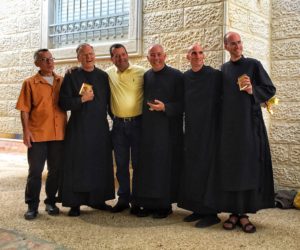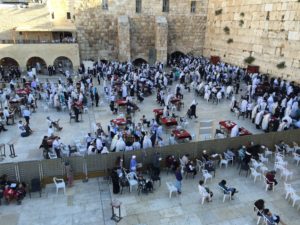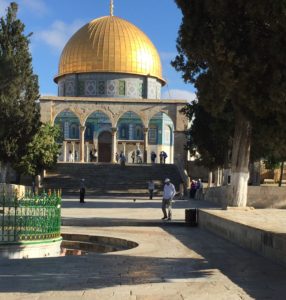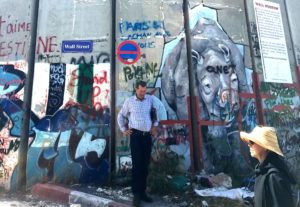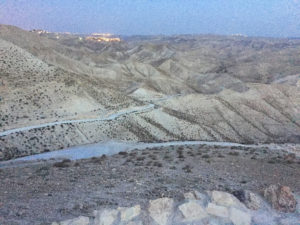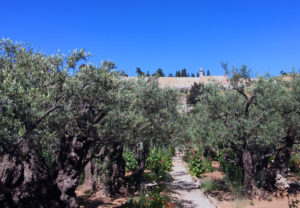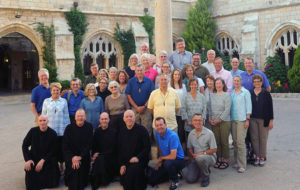In the spring of 2015, within weeks of announcing his retirement from teaching, Scott Christian received an email from the Society of St. John the Evangelist (SSJE), an Episcopal monastery in Cambridge, MA, where he goes on retreat for a week every summer. He learned in the email that four of the SSJE Brothers were leading a pilgrimage to the Holy Land in 2016. Though he had never seriously considered doing this, it seemed to be a timely nudge from God. He immediately signed up…and what follows are excerpts from Scott’s reflections on what turned out to be a transformative experience.
Two students asked a rabbi, “Why does God command us to put the word of God on our hearts? Why did God not say to put God’s word in our hearts?” The rabbi responded, “We are commanded to place the word of God on our hearts because our hearts are closed and the word of God cannot get in. So God commands us to place the word of God on our hearts, and there it sits and waits for the day when our hearts will be broken. When they are broken, then the word of God will fall gently inside.” This parable was shared early on in our Fellowship of St. John Pilgrimage to the Holy Land by one of our leaders, and this pilgrimage indeed broke open my heart. We often talk of God-moments in our lives; these were God-days.
What I didn’t fully appreciate until I was on the pilgrimage was the double bonus I received—not only was I making a Holy Land Pilgrimage with four SSJE Brothers, Curtis, Luke, John and Jim – but our local guides were two very engaging and knowledgeable men: Iyad Qumri, a Palestinian Christian, and Mark Stanger, who was a Canon in the Diocese of San Francisco before he felt the call two years ago to live and work in Israel/Palestine.
Our pilgrimage was centered in Jerusalem and its environs with a 2-day trip to the Nazareth–Sea of Galilee area, driving north close to the Jordan River through Jericho and returning through Samaria. We stayed at the St. George’s Pilgrim Guesthouse located in East Jerusalem, located only a short walk from the Damascus Gate, which leads you into the Old City. Providentially, not only was it Passover when many Jews from all over the world come to Jerusalem, it was also Holy Week in the Orthodox Christian tradition. Despite the large number of people in the city, we avoided most crowds thanks to our experienced guides. Of course, they did have us leave our Guesthouse at 5 a.m. on three mornings!
So what exactly broke open my heart? Here are a few stories.
On a single day in the Old City, we visited one of the holiest sites for each of the three Abrahamic religions, which involved passing through two security checkpoints. First we prayed at the Western (“Wailing”) Wall, divided for men and women. These stones date back to the First Century B.C.E. when King Herod the Great built a retaining wall around the Temple. For present day Jews, the Wall is the place they can worship which is closest to the Temple Mount, where tradition places Abraham, prepared to sacrifice his son Isaac. And Jews have continued to experience God’s presence near this site for over 3,500 years! On the last day of my pilgrimage, I returned to the Wall and witnessed a beautiful scene. A group in the corner of the men’s section was celebrating a Bar Mitzvah, and at one point the men lifted a young boy in a chair and were dancing around holding him up. Then a number of women got up on chairs next to the fence separating them from the men, and they lifted little girls over this fence so that they could participate in this celebration. For me it represented the exuberant nature of the Jewish faith, as they appeared to break the rules to include the whole family. My heart breaks open.
Next we went up on Temple Mount, which the Muslims call the Haram, where centuries ago they built the Dome of the Rock and the Al Aqsa mosque. This is the third holiest site in the Islamic faith, as it is from the rock located inside the dome where Muslims believe Mohammed ascended on his night journey and received the Five Pillars of Islam. I realize this city can’t belong to one faith; it must be shared. Why is that so difficult? Crack goes my heart.
Then after lunch in a local restaurant right off one of the narrow streets in the Old City, we visited the Church of the Holy Sepulchre (or “Holy Mayhem” as one guide described it). Inside are the traditionally recognized sites of Jesus’ Crucifixion and his tomb. Six different Christian groups literally compete for space, and the disagreements among the various Christian sects got so acrimonious that in 1852 they gave the key to the church to a Muslim, whose descendants have been opening the doors each morning ever since! However, seeing Christians from all corners of the globe – Korea, Ghana, Mexico – many prostrating themselves in worship, made me realize how much bigger Christianity is than I had ever imagined, and what a powerful grip Christ’s love has on so many people’s lives. Two billion people worldwide proclaim their faith in Jesus Christ, and I was standing at the physical epicenter of this devotion. Paradoxically, due to the ongoing political tension and violence, the percentage of Christians who actually live in Israel is less than 2% of the population. Therefore our presence, with Jesus as the Supreme Peacemaker, is so desperately needed. It’s too much to wrap my mind around. The crack in my heart opens wider.
One morning, after breakfast in Bethlehem, we walked up to and along the 26-foot security wall that the Israeli government has built around certain Palestinian areas in the West Bank. A Dutch group had printed dozens of huge metal posters and nailed them to the wall. Each one told how the wall had adversely affected a Palestinian’s life. A few in our group openly wept, and Iyad, one of our guides, had his own story of flying back from the U.S. when his mother died, but then not being able to drive the last forty miles to the funeral because of a closed Israeli checkpoint. One night we had an Israeli explain the positions of the various Israeli political parties on the security question and the Oslo Agreement. Few people see any progress for peace in the near future. Big crack.
On one of our 5 a.m. departure mornings we drove northeast out of Jerusalem to Wadi Qelt. We exited the bus and in the faint twilight walked to the top of a mountain and watched the sun rise over the Jordanian desert and mountains in the east. Halfway back down at a small campsite, with Bedouin children waiting patiently to sell us souvenirs, we celebrated Eucharist. Looking to the north, we saw a road that linked Jerusalem to Jericho. Here is the setting for the Parable of the Good Samaritan. Neither the priest nor the Levite hurrying to Jericho stopped; it was the Samaritan, the unclean one, who stopped and cared for the victim. We saw the desolate road, the parable hits home, and God’s Word “falls gently inside” my heart.
Standing outside the Church of the Beatitudes, we looked down the hill towards the Sea of Galilee and could see the contours of the land that form a natural amphitheater, perfect for outdoor preaching. One author called this land “The Fifth Gospel.” We then walked halfway down, stopped under a tree that shaded a makeshift altar, and our joyous band of pilgrims broke bread, praised God and sang hymns, just as Jesus and his disciples did two thousand years ago.
Back in Jerusalem we visited the Mount of Olives and stood in the Garden of Gethsemane. On Maundy Thursday Jesus would have looked out across the Kidron Valley at Jerusalem, where just outside the city walls he would be crucified in less than 24 hours. Near this spot among olive trees Jesus prayed, “Abba, Father, for you all things are possible; remove this cup from me; yet, not what I want, but what you want.” Christ’s love for us pours over my heart.
Our final Eucharist of the pilgrimage was held in the ruins of a Byzantine church near Emmaus, where the Resurrected Jesus was revealed to the two disciples as he took, blessed, broke, and gave them bread. Having spent ten days in intimate communion with thirty-five other pilgrims, my heart was overflowing with gratitude for their fellowship. It occurred to me that God’s truth is too big for a single individual either to understand it or to live it. As Eugene Peterson wrote, “Scripture knows nothing of the solitary Christian.” Community, most powerfully expressed in the Holy Eucharist, is absolutely essential to our faith. As a fellow pilgrim said, “Every time I sat down for a meal, I was happy to be next to anyone and to hear their unique story and to appreciate their God-given gifts.” Can you imagine a church where everybody walked in, expecting to share a pew, and eager to sit next to and get to know a fellow parishioner? Now there’s a vision of heaven on earth!
So back home, how do I keep my heart open to God’s Word? I had a number of big “take-aways” from this pilgrimage…
Thomas Keating, one of the founders of the modern Centering Prayer movement, wrote, “All difficulties in life arise from the monumental illusion that God is distant or absent.” The thoughtfully woven framework that the Brothers created for our pilgrimage gave us the freedom to experience Christ in powerful and ever-present ways. At their monastery the Brothers follow a similar daily pattern, which they call a Rule of Life, and they use the metaphor of a garden trellis, “without whose support and strength, the plant could never grow so wonderfully beautiful, unruly or unique.” And that’s a holy paradox which the Brothers encourage us all to live into—structuring our days to include prayer and study, solitude and fellowship, serving and singing, which will give us a newfound freedom to live a full and balanced life.
The pilgrimage also cemented my belief that the 7.4 billion inhabitants of Earth are all God’s children and my sisters and brothers in Christ. A former Anglican Bishop of Pakistan, Mano Rumalshah, resides and ministers in the Peshawar, a community on the border between Afghanistan and Pakistan, a refuge for the Taliban and one of the most hostile settings on earth. When he created a peace group, he didn’t want to call it “interfaith,” since that typically calls to mind divisions – Hindus, Christians, and Muslims. Instead he called it Faith Friends – letting “faith be the magnet of our relationship.” With the deepening of my own faith over these rich and meaningful days, I have a new appreciation for just how magnetic our faith can be. And I believe more strongly than ever that Love wins.
Thanks to the following pilgrims who allowed me to use one or more of their photographs to supplement mine: Karen Bird, J.C. Snead, and Pat Beamish.
For more information about The Society of St. John the Evangelist (SSJE) visit www.ssje.org


